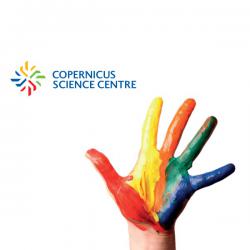November 5, 2015 marks the 5th anniversary of the opening of the Copernicus Science Centre. These past five years have been a time of joy, surprises and opportunities to learn: we have found out a lot about our visitors; we have been improving the Centre on an ongoing basis; and now we are on the eve of bigger changes that have been planned for the whole exhibition space in the coming months. We have also had a chance to learn a lot about the Centre, which allowed us to identify our social role and determine our organisation’s identity. Therefore, now we know where we are heading – we have our vision of development.
After the opening of the Copernicus Science Centre, we were finally able to see how our concepts and predictions look in “real life.” We observed our visitors and conducted research. We kept searching for out-of-the-box ideas; we underwent training and tested new solutions on a regular basis. By modernising particular exhibition elements and rearranging them, we were trying to determine what a “good exhibit” is. We also expanded our offer by organising scientific shows, experiments and workshops in our Centre. We opened new exhibition and science spaces: laboratories, Robotic Theatre, High Voltage Theatre, Thinkatorium and a rooftop garden. Today, on the day of our 5th anniversary, in the Planetarium, we have made available a new, free of charge, permanent exhibition titled Look: Earth. It invites all visitors to look at our planet from a distance and recognise how beautiful and fragile it is. Such a perspective makes us all feel more responsible for the Earth and its inhabitants, and helps us appreciate more the value of the world we are living in — the world we should care about more. The exhibition also presents the universe exploration and space research, and explains how their results are applied in everyday life.
Our innovative hands-on exhibitions, excellent laboratories, state-of-the-art planetarium, rooftop garden and art collection have made the Copernicus Science Centre one of the most visited science centres in Europe with an attendance of over 1 million visitors annually. This continuing success comes as a fantastic surprise, one that results not only in satisfaction but also a challenge.
We are a modern and dynamically operating institution that has been very successful both in Poland and abroad. We have, therefore, had the comfort of resting on our laurels and focusing exclusively on providing our guests with an unforgettable experience. But we want to move forward: we want to find out more and understand better what actually happens at our exhibitions – what educational processes take place there. Such a direction of development is inevitably linked with expanding our activities. That is why the Copernicus Science Centre aims to be a cultural institution able to conduct scientific research. A place where people not only learn science but also actively participate in its creation. And this will soon be possible, now that our CEO and Management have signed a new statute. What a fantastic way to celebrate our 5th anniversary!
“The fundamental purpose of the Copernicus Science Centre is to build science and social capital and transform the learning culture by engaging the society, above all the visitors of our Centre, in various forms of activities. They are the reason why we create exhibits and whole exhibitions as unforgettable experiences of individual hands-on experimenting and exploring. And now we want to include their experiences in our research processes,” – says Robert Firmhofer, the CEO of the CSC.
The idea of cooperating with scientists for the science popularisation has been rooted in our Centre for a long time and has always been developed. In the future we want to organise – here in the CSC, together with scientists – our own research in which the visitors will actually participate. A hands-on exhibition space is a scene tailored for research. How do people learn? How should the exhibit be designed to keep the visitor more focused on it? What does the visitor actually remember two weeks after the visit? The number of potential research topics seems to be virtually unlimited. Such an approach also provides new opportunities for the visitors, who can personally contribute to the development of science.
“The new profile of the organisation requires new types of partnership agreements. The existing partnerships with universities and research institutes, focused on the cooperation in terms of the popularisation of science. The new agreements assume that the Copernicus Science Centre will provide a scene for the research, with the Centre being involved in it in close collaboration with national and international partners,” – says Robert Firmhofer.
One example of such cooperation is the agreement between the Copernicus Science Centre and the Stanford University signed in October 2015, which assumes establishing here in Warsaw an experimental educational programme based on the concept of FabLab@School in collaboration with the Transformative Learning Technologies Lab (TLTL).
In our Copernican Revolution Laboratory, which has been established this year as a separate unit focused on “changing the learning culture,” in which the Copernicus Science Centre is involved, we study and test innovative solutions and develop new educational methods. The effects of these actions will allow us to reach beyond the walls of an ordinary science centre and cooperate with teachers at schools, informal educators and parents.
The process of transforming the Copernicus Science Centre from a factory into a laboratory has only recently begun. Will this attempt to bring live research to the science centre and re-shape its exhibitions and activities into living laboratory be successful? It remains to be seen. It may also become a topic of research one day.

